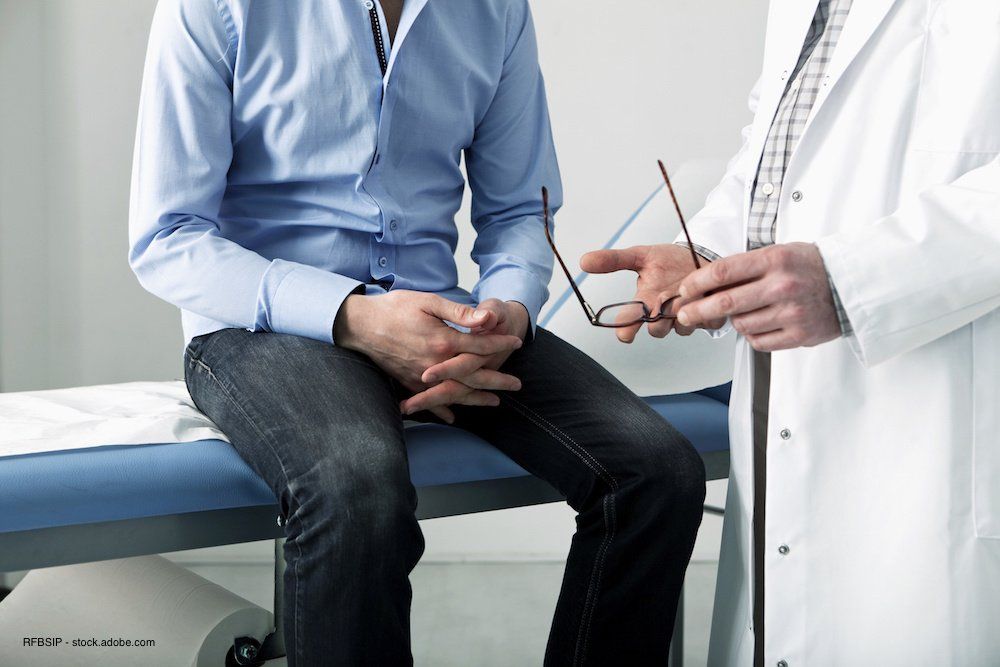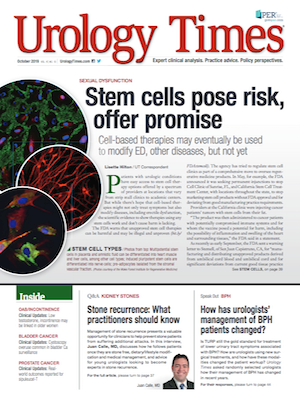Publication
Article
Urology Times Journal
ADT may increase likelihood of urethral atrophy
Author(s):
Androgen deprivation therapy for advanced prostate cancer may increase the likelihood of urethral atrophy in men with an artificial urinary sphincter (AUS), thereby contributing to an increased risk of AUS cuff erosion.
RFBSIP - stock.adobe.com

Androgen deprivation therapy (ADT) for advanced prostate cancer may increase the likelihood of urethral atrophy in men with an artificial urinary sphincter (AUS), thereby contributing to an increased risk of AUS cuff erosion.
In examining a database of men who underwent AUS at a tertiary urban medical center between 2008 and 2017, those with a history of ADT, confirmed by a low serum testosterone level, were 1.5 times more likely to require an AUS cuff of 3.5 cm compared with men with a normal testosterone level and no history of ADT use, reported Michael Davenport, MD, at the AUA annual meeting in Chicago.
The finding confirms previous observations linking hypogonadism, among other factors such as pelvic radiation, to adverse outcomes after sphincter placement, as well as histologic data showing that hypogonadism leads to a decrease in periurethral vascularity and urethral atrophy, said Dr. Davenport, a fellow in reconstructive, trauma, and prosthetic urology, University of Texas Southwestern Medical Center-William P. Clements Jr. University Hospital, Dallas.
Also see: New online men’s health sites divide opinion
Men with primary ADT have also been found to lose penile length, which suggests that castration can lead to genital and urethral atrophy.
Importance of perioperative counseling
Together with these prior findings, the study “confirms the adverse relationship between hypogonadism and urethral homeostasis,” Dr. Davenport said.
“It highlights the importance of perioperative counseling in men with advanced prostate cancer [with a history of ADT use] and potentially compromised urethras, so they go into surgery knowing they have a higher incidence of a poor outcome,” added Dr. Davenport, who worked on the study with Allen F. Morey, MD, and colleagues.
AUS remains the gold standard for the management of male urinary stress incontinence, with patient satisfaction rates consistently greater than 90%. Many men with an AUS, however, require revision or replacement. The primary reason for revision is urethral atrophy, said Dr. Davenport.
Continue to the next page for more.From their database of 643 men who had undergone sphincter replacement, he and co-investigators identified 67 men with a history of ADT in the setting of recurrent disease or in association with radiation and 32 normogonadal men with no history of ADT or radiation (control group). Placement in each group was confirmed serologically by measurement of serum testosterone level. Mean testosterone level was 125.4 in the men on ADT and 483.4 in the controls. Fifty-one of the men (76.1%) on ADT had a history of radiation compared with none of the men with a normal testosterone level.
About half (48.5%) of the men on ADT had urethral atrophy, defined as use of a 3.5-cm AUS cuff, compared with 28.1% in the control group (p=.08). Seventeen of the men on ADT (26.2%) developed AUS cuff erosion compared with one (3.7%) in the normal testosterone group.
Read: Urethral lift found safe, efficacious in real-world setting
“Univariate analysis suggests an increased risk of erosion with history of ADT, but it falls off on multivariate analysis, likely because of the high co-incidence of radiation in this population. It’s very rare to find a patient just receiving ADT without radiation,” said Dr. Davenport.
Among men with 3.5-cm cuffs, the rates of urethral erosion were significantly higher among men who had been on ADT compared with the control group (31.2% vs. 11.1%; p=.04).
A group from Mayo Clinic did not find evidence to support adverse outcomes in ADT-exposed men undergoing primary AUS placement compared with ADT-naïve men, Dr. Davenport noted, but they did not confirm the gonadal state with measurements of serum testosterone and no definition of urethral atrophy was provided (Transl Androl Urol 2016; 5:756-61).
We want to hear from you! Email your thoughts on this article to urology_times@mmhgroup.com.






























